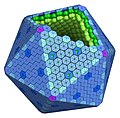Bacterial microcompartment
Bacterial microcompartments (BMCs) are protein-based organelles found in a wide range of bacteria. They serve as specialized compartments for various metabolic processes, encapsulating specific enzymes and substrates to enhance reaction efficiency and protect the cell from toxic intermediates. BMCs are notable for their icosahedral or quasi-icosahedral symmetry and are composed of thousands of protein subunits. They are a key example of the complexity and adaptability of bacterial cells, illustrating how prokaryotes can compartmentalize functions in a manner somewhat analogous to the organelles of eukaryotic cells.
Structure and Function
The structure of BMCs is defined by a protein shell that encapsulates enzymes involved in a specific metabolic pathway. The shell is primarily made up of hexameric and pentameric proteins that form a facetted surface, with pores that allow the selective passage of substrates, products, and cofactors. The most well-studied BMCs are those involved in carbon fixation, the anabolism of ethanolamine, and the degradation of propanediol.
Carbon Fixation BMCs
In cyanobacteria and some chemolithoautotrophs, BMCs encapsulate enzymes of the Calvin cycle, enhancing the efficiency of carbon fixation by concentrating CO2 and excluding oxygen, which can interfere with the enzyme RuBisCO.
Ethanolamine Utilization
Certain pathogenic bacteria, such as Salmonella and Escherichia coli, contain BMCs that metabolize ethanolamine, using it as a nitrogen and carbon source. This process is crucial for their survival in the gut, where ethanolamine is available from the breakdown of phospholipids.
Propanediol Utilization
BMCs involved in the degradation of 1,2-propanediol are found in several bacterial species. This pathway produces propionate and propanol, which can be used as carbon and energy sources. The encapsulation of this pathway helps to sequester the toxic intermediate, propionaldehyde.
Biotechnological Applications
The modular nature of BMCs and their ability to encapsulate specific metabolic pathways have made them a target for biotechnology. Efforts are underway to engineer BMCs to improve biofuel production, carbon capture, and the synthesis of valuable chemicals. By introducing synthetic BMCs into industrial microorganisms, researchers aim to create more efficient and robust production strains.
Evolution
The evolutionary origin of BMCs is a subject of ongoing research. It is believed that they evolved through the duplication and divergence of a primordial protein, leading to the diverse array of BMCs observed today. Their widespread presence in bacteria suggests an ancient origin and a significant evolutionary advantage in certain environments.
See Also
Bacterial_microcompartment
- PDU BMC genes expressed in Escherichia coli.jpeg
PDU BMC genes expressed in Escherichia coli
Transform your life with W8MD's budget GLP-1 injections from $125.
W8MD offers a medical weight loss program to lose weight in Philadelphia. Our physician-supervised medical weight loss provides:
- Most insurances accepted or discounted self-pay rates. We will obtain insurance prior authorizations if needed.
- Generic GLP1 weight loss injections from $125 for the starting dose.
- Also offer prescription weight loss medications including Phentermine, Qsymia, Diethylpropion, Contrave etc.
NYC weight loss doctor appointments
Start your NYC weight loss journey today at our NYC medical weight loss and Philadelphia medical weight loss clinics.
- Call 718-946-5500 to lose weight in NYC or for medical weight loss in Philadelphia 215-676-2334.
- Tags:NYC medical weight loss, Philadelphia lose weight Zepbound NYC, Budget GLP1 weight loss injections, Wegovy Philadelphia, Wegovy NYC, Philadelphia medical weight loss, Brookly weight loss and Wegovy NYC
|
WikiMD's Wellness Encyclopedia |
| Let Food Be Thy Medicine Medicine Thy Food - Hippocrates |
Medical Disclaimer: WikiMD is not a substitute for professional medical advice. The information on WikiMD is provided as an information resource only, may be incorrect, outdated or misleading, and is not to be used or relied on for any diagnostic or treatment purposes. Please consult your health care provider before making any healthcare decisions or for guidance about a specific medical condition. WikiMD expressly disclaims responsibility, and shall have no liability, for any damages, loss, injury, or liability whatsoever suffered as a result of your reliance on the information contained in this site. By visiting this site you agree to the foregoing terms and conditions, which may from time to time be changed or supplemented by WikiMD. If you do not agree to the foregoing terms and conditions, you should not enter or use this site. See full disclaimer.
Credits:Most images are courtesy of Wikimedia commons, and templates, categories Wikipedia, licensed under CC BY SA or similar.
Contributors: Prab R. Tumpati, MD


